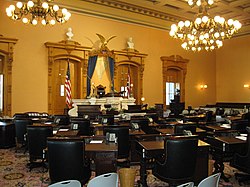Ohio Senate | |
|---|---|
| 135th Ohio General Assembly | |
 | |
| Type | |
| Type | |
Term limits | 2 terms (8 years) |
| History | |
New session started | January 6, 2025 |
| Leadership | |
President pro tempore | |
Majority Leader | |
Minority Leader | |
| Structure | |
| Seats | 33 |
 | |
Political groups | Majority
Minority
|
Length of term | 4 years |
| Authority | Article II, Ohio Constitution |
| Salary | $68,674/year |
| Elections | |
Last election | November 5, 2024 (16 seats) |
Next election | November 3, 2026 (17 seats) |
| Meeting place | |
 | |
| Senate Chamber Ohio Statehouse Columbus, Ohio | |
| Website | |
| ohiosenate | |
The Ohio Senate is the upper house of the Ohio General Assembly. The State Senate, which meets in the Ohio Statehouse in Columbus, first convened in 1803. Senators are elected for four year terms, staggered every two years such that half of the seats are contested at each election. [1] Even numbered seats and odd numbered seats are contested in separate election years. The president of the Ohio Senate presides over the body when in session, and is currently Rob McColley.
Contents
- Composition
- Leadership
- Members of the 136th Senate
- Past composition of the Senate
- References
- External links
Currently, the Senate consists of 24 Republicans and 9 Democrats, with the Republicans controlling two more seats than the 22 required for a supermajority vote. Senators are limited to two consecutive terms. Each senator represents approximately 349,000 Ohioans, and each Senate district encompasses three corresponding Ohio House of Representatives districts.


